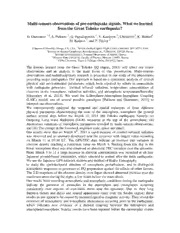
NASA Technical Reports Server (NTRS) 20120013621: Multi-Sensors Observations of Pre-Earthquake Signals. What We Learned from the Great Tohoku Earthquake? PDF
Preview NASA Technical Reports Server (NTRS) 20120013621: Multi-Sensors Observations of Pre-Earthquake Signals. What We Learned from the Great Tohoku Earthquake?
Multi-sensors observations of pre-earthquake signals. What we learned from the Great Tohoku earthquake? D. Ouzounov 1,2, S. Pulinets 3, G. Papadopoulos 4, V. Kunitsyn 5, I.Nesterov5, K. Hattori6 M. Kafatos 1, and P. Taylor 2 1Chapman University, Orange, CA, USA, 2 NASA Goddard Space Flight Center, Greenbelt, MD 20771, USA 3Institute of Applied Geophysics, Rostokinskaya str., 9, Moscow, 129128, Russia 4 Institute of Geodynamics, National Observatory of Athens, Greece 5 Moscow State University, Faculty of Physics, Moscow 119991, Russia 6 Chiba University, Yayoi 1-33,Inage, Chiba, 263-8522, Japan, The lessons learned from the Great Tohoku EQ (Japan, 2011) will affect our future observations and an analysis is the main focus of this presentation. Multi-sensors observations and multidisciplinary research is presented in our study of the phenomena preceding major earthquakes Our approach is based on a systematic analysis of several physical and environmental parameters, which been reported by others in connections with earthquake processes: thermal infrared radiation; temperature; concentration of electrons in the ionosphere; radon/ion activities; and atmospheric temperature/humidity [Ouzounov et al, 2011]. We used the Lithosphere-Atmosphere-Ionosphere Coupling (LAIC) model, one of several possible paradigms [Pulinets and Ouzounov, 2011] to interpret our observations. We retrospectively analyzed the temporal and spatial variations of three different physical parameters characterizing the state of the atmosphere, ionosphere the ground surface several days before the March 11, 2011 M9 Tohoku earthquake Namely: (i) Outgoing Long wave Radiation (OLR) measured at the top of the atmosphere; (ii) Anomalous variations of ionospheric parameters revealed by multi-sensors observations; and (iii) The change in the foreshock sequence (rate, space and time); Our results show that on March 8th, 2011 a rapid increase of emitted infrared radiation was observed and an anomaly developed near the epicenter with largest value occurring on March 11 at 07.30 LT. The GPS/TEC data indicate an increase and variation in electron density reaching a maximum value on March 8. Starting from this day in the lower ionosphere there was also observed an abnormal TEC variation over the epicenter. From March 3 to 11 a large increase in electron concentration was recorded at all four Japanese ground-based ionosondes, which returned to normal after the main earthquake. We use the Japanese GPS network stations and method of Radio Tomography to study the spatiotemporal structure of ionospheric perturbations, and to distinguish ionospheric responses to processes of EQ preparation against the effects of other factors. The 2-D snapshots of the electron density over Japan showed abnormal increase over the maximum stress during the night, a few hours before the main shock. Our results from recording atmospheric and ionospheric conditions during the earthquake indicate the presence of anomalies in the atmosphere and ionospheres occurring consistently over regions of maximum stress near the epicenter. Due to their long duration (hours and days) and spatial appearance (only over the Sendai region) these results do not appear to be caused by meteorological or magnetic activity. They reveal the existence of atmospheric and ionospheric phenomena occurring prior to the earthquake, which indicates new evidence of a distinct coupling between the lithosphere and atmosphere/ionosphere. Similar results have been reported before the catastrophic events in Chile (M8.8, 2010), Italy (M6.3, 2009) and Sumatra (M9.3, 2004). In addition to atmospheric and ionospheric analysis we have noted the foreshock sequence, to search for a common precursory pattern. Foreshock activity became evident only two days before the main shock (March 9), starting with a large foreshock of magnitude 7, while there was a 400 km radii of activity around the epicenter, which indicates that the foreshock area may be dependent on the magnitude of the main shock. Preliminary analysis of the time varying of foreshock sequence, atmospheric and ionospheric parameters during this earthquake has revealed the temporal and spatial occurrence of related variations of these parameters implying their connection with the earthquake process. We expect that our analysis will shed light on the underlying physics of pre-earthquake signals associated with some of the largest earthquake events Ouzounov D., S. Pulinets, A. Romanov, A. Romanov Jr., K. Tsybulya, D.Davydenko, M. Kafatos and P. Taylor (2011) Atmosphere-Ionosphere Response to the M9 Tohoku Earthquake Reviled by Joined Satellite and Ground Observations, Earthquake Science, 24, 557–564 Pulinets S. and D.Ouzounov (2011) Lithosphere-Atmosphere-Ionosphere Coupling (LAIC) model - an unified concept for earthquake precursors validation, Journal of Asian Earth Sciences, 41, 4-5, 371-382
